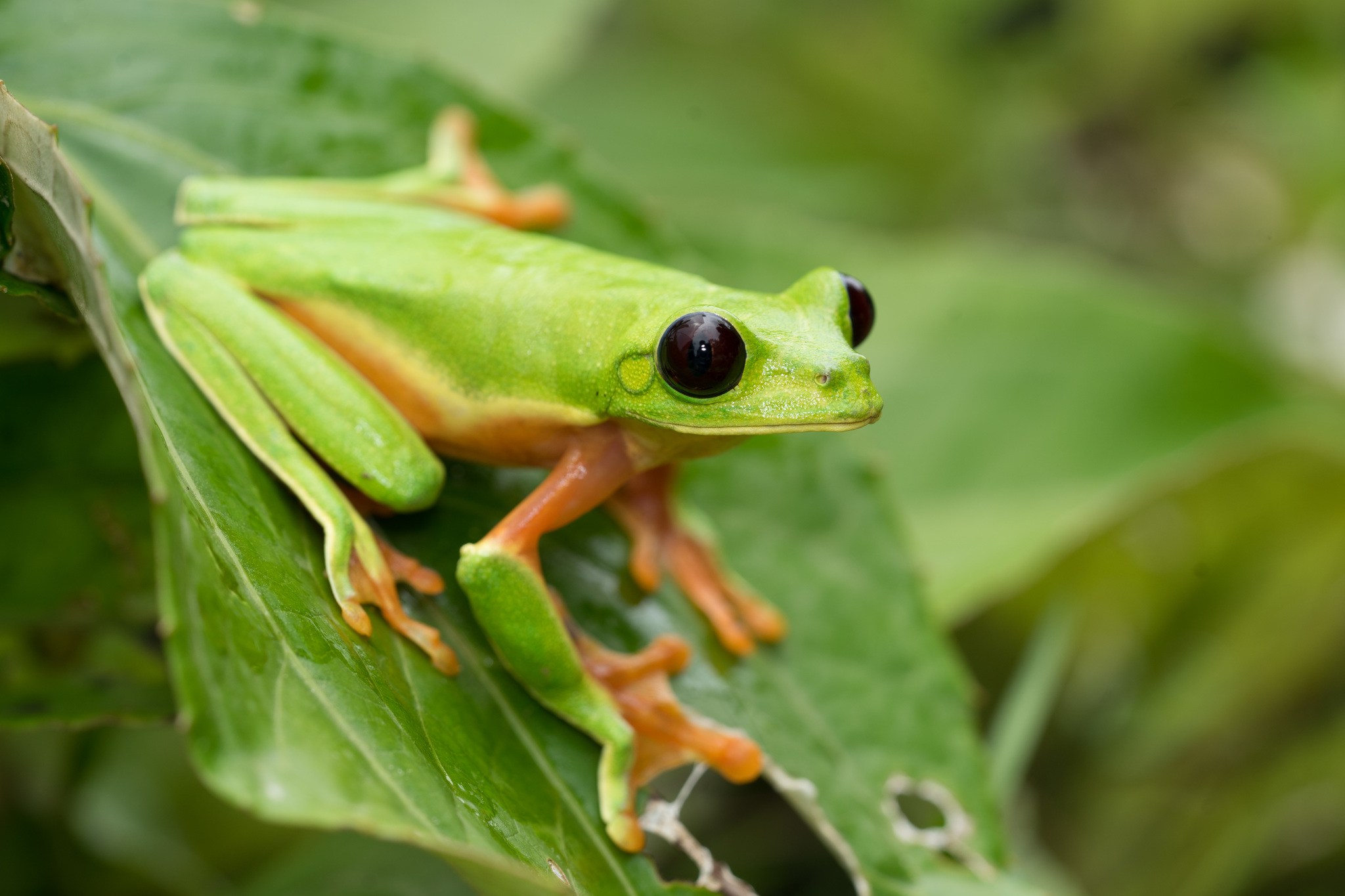
Black eyed tree frogs, also known as Agalychnis moreletii, are captivating creatures that can be found in the lush rainforests of Mexico and Central America. These miniature amphibians, with their vibrant green bodies and their distinctive black eyes, have long been the subject of fascination for both nature enthusiasts and researchers alike.
In this article, we will dive into the world of black eyed tree frogs and uncover 10 fascinating facts about these incredible creatures. From their unique physical features to their exceptional adaptations, there is so much to learn and appreciate about these small but mighty frogs. So, get ready to hop right in and explore the intriguing world of black eyed tree frogs!
Key Takeaways:
- The Black Eyed Tree Frog is a colorful, agile amphibian found in Central and South America, known for its striking black eyes and ability to change color from day to night.
- These nocturnal frogs are expert jumpers with sticky toe pads, and they have a unique breeding behavior, making them highly adaptable to various habitats.
The Black Eyed Tree Frog is a small amphibian found in Central and South America.
The Black Eyed Tree Frog, scientifically known as Agalychnis moreletii, is a fascinating amphibian native to the tropical rainforests of Central and South America. With its vibrant colors and unique physical characteristics, this frog is a sight to behold.
They get their name from their striking black-colored eyes.
One of the most distinctive features of the Black Eyed Tree Frog is its large, bulging black eyes. These eyes not only provide excellent vision but also serve as a defense mechanism to ward off potential predators.
They have a bright green body with blue and yellow accents.
The Black Eyed Tree Frog showcases a stunning combination of colors. Its body is primarily bright green, which helps it blend in with the lush green foliage of its natural habitat. It also sports vibrant blue and yellow accents on its legs and sides.
These frogs are expert jumpers.
The Black Eyed Tree Frog has powerful hind legs that allow it to leap great distances. It uses its jumping ability to navigate through the trees and evade predators. With its remarkable agility, this frog can cover long distances in a single bound.
They are nocturnal creatures.
The Black Eyed Tree Frog is primarily active during the night, hunting for insects and other small invertebrates. During the daytime, it rests on leaves or tree branches, using its camouflage to blend in seamlessly with its surroundings.
Black Eyed Tree Frogs undergo a dramatic color change from day to night.
During the daytime, these frogs have a bright green coloration, which helps them remain inconspicuous while resting. However, at night, their skin transforms into a darker shade of green or brown to assist with nighttime hunting activities.
They possess sticky pads on their toes.
Their specialized toe pads enable the Black Eyed Tree Frog to grip onto smooth surfaces such as leaves and branches. This adaptation allows them to climb and move effortlessly in the dense trees of their rainforest habitat.
Their diet consists mainly of insects.
Being carnivorous creatures, Black Eyed Tree Frogs primarily feed on a variety of insects, including crickets, beetles, moths, and ants. Their long, sticky tongue helps them capture their prey with precision and accuracy.
They have a unique breeding behavior.
During the breeding season, male Black Eyed Tree Frogs will emit distinct vocalizations to attract females. Once a female is selected, the male will grasp onto her back, and they will engage in amplexus, a mating position where the male fertilizes the female’s eggs externally.
Black Eyed Tree Frogs are highly adaptable to their environment.
These resilient frogs have the ability to adapt to various habitats, including forests, swamps, and even human-altered landscapes. This adaptability has ensured their survival in a rapidly changing world.
Conclusion
In conclusion, the black-eyed tree frog is a fascinating and unique species. With its vibrant colors, distinct features, and interesting behaviors, it captures the attention of nature enthusiasts and animal lovers alike. From its ability to change colors to camouflage itself, to its impressive jumping abilities, this tiny amphibian leaves a lasting impression.The black-eyed tree frog’s habitat in the rainforests of Central and South America is essential for its survival. Conserving these fragile ecosystems is crucial to ensure the continued existence of this incredible creature. By learning more about the black-eyed tree frog and raising awareness about its importance, we can help protect its natural habitat and contribute to the preservation of biodiversity.If you ever have the opportunity to encounter a black-eyed tree frog in the wild or in captivity, take the time to observe and appreciate its beauty. These little creatures are truly remarkable and contribute to the rich tapestry of the animal kingdom.
FAQs
Q: What is the average size of a black-eyed tree frog?
A: The black-eyed tree frog measures around 2.5 to 3 inches in length, making it a relatively small species of frog.
Q: Are black-eyed tree frogs venomous?
A: No, black-eyed tree frogs are not venomous. They pose no threat to humans or other animals.
Q: What is the diet of a black-eyed tree frog?
A: Black-eyed tree frogs primarily feed on insects, such as crickets, flies, and beetles. They are opportunistic hunters and have a voracious appetite.
Q: How long do black-eyed tree frogs live?
A: On average, black-eyed tree frogs have a lifespan of 8 to 10 years. However, with proper care and optimal conditions, they can live even longer.
Q: Do black-eyed tree frogs have any predators?
A: Yes, black-eyed tree frogs have natural predators, including snakes, birds, and larger reptiles. They rely on their remarkable camouflage abilities to avoid detection.
Q: Are black-eyed tree frogs endangered?
A: The black-eyed tree frog is currently listed as a species of “Least Concern” on the IUCN Red List. However, habitat loss and degradation pose a potential threat to their future survival.
Q: Can black-eyed tree frogs live in captivity?
A: Yes, black-eyed tree frogs can be kept as pets in suitable captive environments. However, it’s important to provide them with proper care and replicate their natural habitat as closely as possible.
Q: How do black-eyed tree frogs reproduce?
A: Black-eyed tree frogs undergo external fertilization. The female lays her eggs on leaves above a source of water, and the male fertilizes the eggs externally. The tadpoles then hatch and live in water until they transform into adult frogs.
Q: Are there any interesting facts about black-eyed tree frogs?
A: Black-eyed tree frogs have the ability to change color, ranging from bright green to dark brown, depending on their environment and mood. They also have a unique adaptation called “telescoping eyes” that allows them to protrude their eyes to spot predators.
Q: Can black-eyed tree frogs vocalize?
A: Yes, black-eyed tree frogs can produce a variety of calls. Males often use their vocalizations to attract females and establish territory.
Was this page helpful?
Our commitment to delivering trustworthy and engaging content is at the heart of what we do. Each fact on our site is contributed by real users like you, bringing a wealth of diverse insights and information. To ensure the highest standards of accuracy and reliability, our dedicated editors meticulously review each submission. This process guarantees that the facts we share are not only fascinating but also credible. Trust in our commitment to quality and authenticity as you explore and learn with us.


